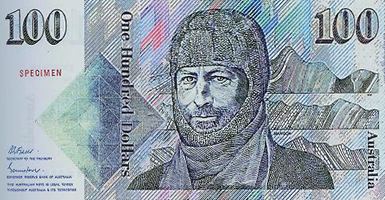Value 100 Australian dollars Height 65 mm | Width 158 mm Paper type Polymer | |
 | ||
Security features Clear Window with Embossing, Micro Printing, Slightly Raised Printing, Hold the note towards light and the Australian Coat Of Arms plus a seven pointed star will appear, Ultra Violet, Unic Serial Number and different fonts, Watermark Years of printing 1996, 1998–99, 2008, 2010–11, 2013-14 | ||
The Australian one hundred-dollar banknote was first issued, as a paper note, in 1984. There have been only two different issues of this denomination: initially a greyish blue paper note, and from May 1996, a green polymer note.
Contents
According to Reserve Bank of Australia statistics, the number of $100 banknotes in circulation in June 2005 was 149 million, or 18.5% of all notes in circulation. The cash value for these notes was $14,924 million, or 41.9% of the total value for all denominations. Only the $50 note had more cash value in circulation. Updated figures to June 2008 were 176.9 million, or 19%, and $17,690,000,000, or 42.1%. Again, the value of cash in circulation is more for the $50 note. This can be explained by the fact that most automated teller machines dispense $20 and $50 notes, but not $100 notes.
As of December 2016, 300 million $100 notes were in circulation, 22% of the total notes in circulation; worth $29,951 million, or 46% of the total value for all denominations.
Since the start of issuance there have been six signature combinations. Two other combinations were not issued.
Since 1973, the main title identifying the country on banknotes has been "Australia". The denominations issued prior to 1973 used "Commonwealth of Australia".
In December 2016, it was reported that Australia may abolish its $100 note to close down Loopholes used by the black economy.
Design
The paper issue has a portrait of Antarctic explorer Sir Douglas Mawson, with a background of a mountain range with a geological strata format. A large diamond shape appears to the left of the main picture. Astronomer John Tebbutt is on the reverse, with a background of the observatory he built and a local church.
The polymer issue was designed by Bruce Stewart, and features portraits of soprano Dame Nellie Melba and engineer and First World War general Sir John Monash.
Security features
The paper design includes a watermark of Captain James Cook in the white field, and a metallic strip embedded in the paper to the left (on the obverse side) of the note. The same watermark was used in the last issue of the pre-decimal banknotes.
The polymer issue includes a shadow image of the Australian Coat of Arms, which is printed over. In the clear window, there is embossing—or a raised image—of the number 100 and a print of a lyrebird. Also for this issue, fluorescent colouring was added to the serial numbers, as well as a patch that shows the banknote's value under ultraviolet light. The star's four points on the obverse and three on the reverse join to form the seven-pointed Federation Star when the note is held up to the light. Raised print and micro-printing of the denomination value are also included.
